My Essentials Window in Photoshop Went Wide and I Need to Make It Skinny Again
- Photoshop User Guide
- Introduction to Photoshop
- Dream information technology. Make information technology.
- What's new in Photoshop
- Edit your kickoff photo
- Create documents
- Photoshop | Common Questions
- Photoshop arrangement requirements
- Drift presets, actions, and settings
- Become to know Photoshop
- Photoshop and Adobe services
- Photoshop and Adobe Stock
- Artistic Cloud Libraries
- Creative Deject Libraries in Photoshop
- Utilise the Bear upon Bar with Photoshop
- Work with Illustrator artwork in Photoshop
- Utilize the Capture in-app extension in Photoshop
- Grid and guides
- Creating actions
- Disengage and history
- Default keyboard shortcuts
- Bear on capabilities and customizable workspaces
- Photoshop on the iPad
- Photoshop on the iPad | Common questions
- Become to know the workspace
- System requirements | Photoshop on the iPad
- Create, open, and export documents
- Add photos
- Piece of work with layers
- Draw and paint with brushes
- Make selections and add masks
- Retouch your composites
- Work with aligning layers
- Adjust the tonality of your composite with Curves
- Utilize transform operations
- Crop and rotate your composites
- Rotate, pan, zoom, and reset the canvas
- Work with Type layers
- Work with Photoshop and Lightroom
- Go missing fonts in Photoshop on the iPad
- Japanese Text in Photoshop on the iPad
- Manage app settings
- Bear upon shortcuts and gestures
- Keyboard shortcuts
- Edit your image size
- Livestream as y'all create in Photoshop on the iPad
- Correct imperfections with the Healing Brush
- Create brushes in Capture and use them in Photoshop
- Work with Camera Raw files
- Create and piece of work with Smart Objects
- Adjust exposure in your images with Contrivance and Burn down
- Photoshop on the web beta
- Mutual questions | Photoshop on the web beta
- Introduction to the workspace
- System requirements | Photoshop on the web beta
- Keyboard shortcuts | Photoshop on the spider web beta
- Supported file types | Photoshop on the spider web beta
- Open and work with deject documents
- Collaborate with stakeholders
- Employ express edits to your deject documents
- Cloud documents
- Photoshop cloud documents | Common questions
- Photoshop cloud documents | Workflow questions
- Manage and work with cloud documents in Photoshop
- Upgrade cloud storage for Photoshop
- Unable to create or save a deject document
- Solve Photoshop cloud document errors
- Collect cloud document sync logs
- Share admission and edit your deject documents
- Share files and annotate in-app
- Workspace
- Workspace basics
- Create documents
- Use the Touch on Bar with Photoshop
- Microsoft Dial back up in Photoshop
- Tool galleries
- Operation preferences
- Employ tools
- Bear on gestures
- Touch capabilities and customizable workspaces
- Engineering science previews
- Metadata and notes
- Quickly share your creations
- Place Photoshop images in other applications
- Preferences
- Default keyboard shortcuts
- Rulers
- Bear witness or hibernate non-printing Extras
- Specify columns for an paradigm
- Undo and history
- Panels and menus
- Place files
- Position elements with snapping
- Position with the Ruler tool
- Presets
- Customize keyboard shortcuts
- Grid and guides
- Web, screen, and app design
- Photoshop for blueprint
- Artboards
- Device Preview
- Re-create CSS from layers
- Slice web pages
- HTML options for slices
- Change slice layout
- Work with web graphics
- Create web photo galleries
- Prototype and colour basics
- How to resize images
- Work with raster and vector images
- Image size and resolution
- Acquire images from cameras and scanners
- Create, open up, and import images
- View images
- Invalid JPEG Marking mistake | Opening images
- Viewing multiple images
- Customize color pickers and swatches
- High dynamic range images
- Match colors in your image
- Catechumen between colour modes
- Color modes
- Erase parts of an epitome
- Blending modes
- Cull colors
- Customize indexed color tables
- Prototype data
- Distort filters are unavailable
- About color
- Color and monochrome adjustments using channels
- Choose colors in the Color and Swatches panels
- Sample
- Colour mode or Prototype fashion
- Color cast
- Add together a conditional mode alter to an action
- Add together swatches from HTML CSS and SVG
- Flake depth and preferences
- Layers
- Layer basics
- Nondestructive editing
- Create and manage layers and groups
- Select, group, and link layers
- Identify images into frames
- Layer opacity and blending
- Mask layers
- Apply Smart Filters
- Layer comps
- Motility, stack, and lock layers
- Mask layers with vector masks
- Manage layers and groups
- Layer effects and styles
- Edit layer masks
- Excerpt assets
- Reveal layers with clipping masks
- Generate image assets from layers
- Work with Smart Objects
- Blending modes
- Combine multiple images into a group portrait
- Combine images with Auto-Blend Layers
- Marshal and distribute layers
- Copy CSS from layers
- Load selections from a layer or layer mask's boundaries
- Knockout to reveal content from other layers
- Layer
- Flattening
- Composite
- Groundwork
- Selections
- Select and Mask workspace
- Make quick selections
- Get started with selections
- Select with the marquee tools
- Select with the lasso tools
- Select a color range in an paradigm
- Adjust pixel selections
- Convert betwixt paths and selection borders
- Channel basics
- Movement, copy, and delete selected pixels
- Create a temporary quick mask
- Save selections and alpha channel masks
- Select the image areas in focus
- Duplicate, split, and merge channels
- Channel calculations
- Selection
- Bounding box
- Image adjustments
- Perspective warp
- Reduce photographic camera shake blurring
- Healing brush examples
- Export colour lookup tables
- Adapt image sharpness and mistiness
- Sympathise color adjustments
- Employ a Brightness/Contrast aligning
- Arrange shadow and highlight item
- Levels adjustment
- Adjust hue and saturation
- Adjust vibrance
- Adapt color saturation in paradigm areas
- Brand quick tonal adjustments
- Apply special color effects to images
- Heighten your paradigm with color remainder adjustments
- Loftier dynamic range images
- View histograms and pixel values
- Match colors in your prototype
- How to crop and straighten photos
- Convert a colour prototype to black and white
- Adjustment and fill layers
- Curves adjustment
- Blending modes
- Target images for press
- Adjust color and tone with Levels and Curves eyedroppers
- Adjust HDR exposure and toning
- Filter
- Blur
- Dodge or burn down image areas
- Make selective color adjustments
- Replace object colors
- Adobe Camera Raw
- Camera Raw system requirements
- What's new in Photographic camera Raw
- Introduction to Camera Raw
- Create panoramas
- Supported lenses
- Vignette, grain, and dehaze effects in Photographic camera Raw
- Default keyboard shortcuts
- Automatic perspective correction in Camera Raw
- How to make not-destructive edits in Camera Raw
- Radial Filter in Camera Raw
- Manage Camera Raw settings
- Open up, process, and save images in Camera Raw
- Repair images with the Enhanced Spot Removal tool in Camera Raw
- Rotate, crop, and suit images
- Adjust colour rendering in Camera Raw
- Feature summary | Adobe Photographic camera Raw | 2022 releases
- New features summary
- Procedure versions in Camera Raw
- Make local adjustments in Photographic camera Raw
- Paradigm repair and restoration
- Remove objects from your photos with Content-Aware Fill
- Content-Aware Patch and Move
- Retouch and repair photos
- Correct epitome distortion and racket
- Basic troubleshooting steps to gear up most issues
- Epitome transformations
- Transform objects
- Adjust crop, rotation, and canvas size
- How to crop and straighten photos
- Create and edit panoramic images
- Warp images, shapes, and paths
- Vanishing Point
- Use the Liquify filter
- Content-aware scaling
- Transform images, shapes, and paths
- Warp
- Transform
- Panorama
- Drawing and painting
- Paint symmetrical patterns
- Draw rectangles and modify stroke options
- Well-nigh drawing
- Draw and edit shapes
- Painting tools
- Create and change brushes
- Blending modes
- Add color to paths
- Edit paths
- Paint with the Mixer Brush
- Brush presets
- Gradients
- Gradient interpolation
- Fill up and stroke selections, layers, and paths
- Draw with the Pen tools
- Create patterns
- Generate a pattern using the Pattern Maker
- Manage paths
- Manage pattern libraries and presets
- Draw or paint with a graphics tablet
- Create textured brushes
- Add dynamic elements to brushes
- Gradient
- Paint stylized strokes with the Fine art History Brush
- Paint with a pattern
- Sync presets on multiple devices
- Text
- Work with OpenType SVG fonts
- Format characters
- Format paragraphs
- How to create blazon effects
- Edit text
- Line and character spacing
- Arabic and Hebrew type
- Fonts
- Troubleshoot fonts
- Asian type
- Create type
- Text Engine error using Type tool in Photoshop | Windows 8
- World-Ready composer for Asian Scripts
- How to add and edit the text in Photoshop
- Video and animation
- Video editing in Photoshop
- Edit video and animation layers
- Video and blitheness overview
- Preview video and animations
- Paint frames in video layers
- Import video files and image sequences
- Create frame animations
- Creative Cloud 3D Animation (Preview)
- Create timeline animations
- Create images for video
- Filters and furnishings
- Apply the Liquify filter
- Use the Mistiness Gallery
- Filter nuts
- Filter furnishings reference
- Add together Lighting Effects
- Use the Adaptive Wide Angle filter
- Use the Oil Paint filter
- Layer furnishings and styles
- Utilise specific filters
- Smudge image areas
- Saving and exporting
- Save your files in Photoshop
- Export your files in Photoshop
- Supported file formats
- Save files in graphics formats
- Move designs between Photoshop and Illustrator
- Save and export video and animations
- Save PDF files
- Digimarc copyright protection
- Save your files in Photoshop
- Press
- Impress 3D objects
- Impress from Photoshop
- Print with color direction
- Contact Sheets and PDF Presentations
- Print photos in a picture package layout
- Print spot colors
- Duotones
- Print images to a commercial press press
- Improve color prints from Photoshop
- Troubleshoot printing problems | Photoshop
- Automation
- Creating actions
- Create data-driven graphics
- Scripting
- Procedure a batch of files
- Play and manage actions
- Add conditional actions
- Nigh actions and the Deportment panel
- Record tools in actions
- Add a conditional mode modify to an action
- Photoshop UI toolkit for plug-ins and scripts
- Colour Management
- Understanding color management
- Keeping colors consistent
- Color settings
- Piece of work with color profiles
- Color-managing documents for online viewing
- Color-managing documents when printing
- Color-managing imported images
- Proofing colors
- Content authenticity
- Learn about content credentials
- Identity and provenance for NFTs
- Connect accounts for artistic attribution
- 3D and technical imaging
- Photoshop 3D | Common questions effectually discontinued 3D features
- Creative Cloud 3D Animation (Preview)
- Print 3D objects
- 3D painting
- 3D panel enhancements | Photoshop
- Essential 3D concepts and tools
- 3D rendering and saving
- Create 3D objects and animations
- Epitome stacks
- 3D workflow
- Measurement
- DICOM files
- Photoshop and MATLAB
- Count objects in an image
- Combine and convert 3D objects
- 3D texture editing
- Suit HDR exposure and toning
- 3D console settings
Liquify filter overview
The Liquify filter lets you push button, pull, rotate, reflect, pucker, and bloat whatever area of an prototype. The distortions y'all create can be subtle or desperate, which makes the Liquify command a powerful tool for retouching images equally well as creating artistic effects. The Liquify filter can be applied to 8‑bits per-channel or 16‑bits per-channel images.

Tools, options, and an prototype preview for the Liquify filter are bachelor in the Liquify dialog box. To brandish the dialog box, choose Filter > Liquify. Select Advanced Mode to access more options.
Magnify or reduce the preview image
Select the Zoom tool in the Liquify dialog box, and click or drag in the preview epitome to zoom in; agree down Alt (Windows) or Option (Mac), and click or drag in the preview image to zoom out. Alternatively, you can specify a magnification level in the Zoom text box at the bottom of the dialog box.
Navigate in the preview image
Select the Mitt tool in the Liquify dialog box, and drag in the preview epitome. Alternatively, concur downwards the spacebar with any tool selected, and drag in the preview epitome.
Liquify filter enhancements (Creative Cloud but)
In the Artistic Cloud version of Photoshop, the Liquify filter is significantly faster than previous versions. The Liquify filter now supports Smart Objects, including Smart Object video layers, and is applied every bit a smart filter.
Another enhancement to the Liquify filter is an added behavior for the Reconstruct tool. If you lot concord downwardly the alt (Windows) or Option (Mac Os) cardinal while dragging the tool beyond a warp, the Reconstruct tool smooths a warp rather than scaling dorsum or removing it.
Applying Liquify every bit a smart filter (Artistic Cloud only)
The Liquify filter supports Smart Objects, including Smart Object video layers, and is applied as a smart filter. When applying the Liquify filter to a Smart Object, meshes are now automatically saved into your document. Meshes applied to Smart Objects are compressed and re-editable when reapplying the Liquify filter. Keep in mind that the embedded meshes, even compressed ones, increment the file size.
To apply the Liquify filter equally a smart filter:
-
In the Layers panel, select a Smart Object layer.
Face-Aware Liquify
Introduced in Photoshop CC 2015.five release
The Liquify filter features avant-garde face-enlightened functionality that automatically identifies eyes, noses, mouths, and other facial features, making it piece of cake for you to adjust them. Face up-Aware Liquify is corking for retouching portrait photos, creating caricatures, and doing much more.
You can utilise Face-Aware Liquify as a smart filter for non-destructive editing. See ![]() Utilise smart filters in Photoshop to understand how.
Utilise smart filters in Photoshop to understand how.
Prerequisite: Enable the graphics processor
As a prerequisite to using Face-enlightened Liquify functionality, ensure that the graphics processor is enabled in your Photoshop preferences.
- CullEdit > Preferences > Performance.
- In the Graphics Processor Settings area, select Use Graphics Processor.
- Click Avant-garde Settings. Ensure that Employ Graphics Processor To Advance Computation is selected.
- Click OK.
These settings are enabled by default when you launch Photoshop for the first time. If you have questions regarding GPU usage in Photoshop, consult ![]() this document.
this document.
Arrange facial features using on-screen handles
- In Photoshop, open up an paradigm with one or more faces.
- Select Filter > Liquify. Photoshop opens the Liquify filter dialog.
- In the Tools panel, select
 (Face tool; keyboard shortcut: A). The faces in the photo are automatically identified.
(Face tool; keyboard shortcut: A). The faces in the photo are automatically identified.

- When you hover the arrow over the faces, Photoshop displays intuitive on-screen controls around them. Adjust the controls to make adjustments to the faces. For example, you lot can increment the centre size or decrease the face width.
- When you're satisfied with the changes, click OK.
Adjust facial features using sliding controls
- In Photoshop, open an epitome with one or more faces.
- Select Filter > Liquify. Photoshop opens the Liquify filter dialog.
- In the Tools panel, select
 (Face tool; keyboard shortcut: A).
(Face tool; keyboard shortcut: A).The faces in the photo are automatically identified and one of the faces selected. The identified faces are also listed in the Select Face pop-up carte du jour in the Confront-Aware Liquify surface area of the Properties panel. You can select a unlike face by clicking it on the sail or selecting it from the pop-up menu.

- Adjust the sliders in the Face up-Aware Liquify area to make advisable changes to the facial features.
Move the slider options for the left and right eyes to utilise independent/asymmetrical furnishings to the eyes.
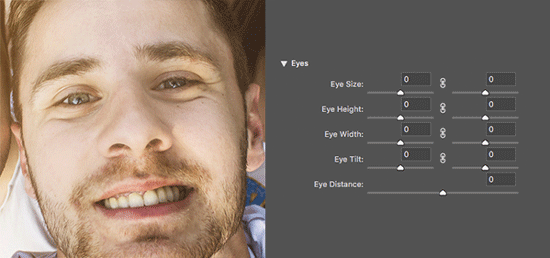
Click the link icon![]() to lock the settings for the left and right eyes together. This option helps use symmetrical effects to the eyes.
to lock the settings for the left and right eyes together. This option helps use symmetrical effects to the eyes.
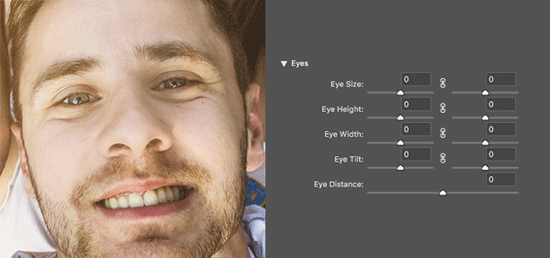
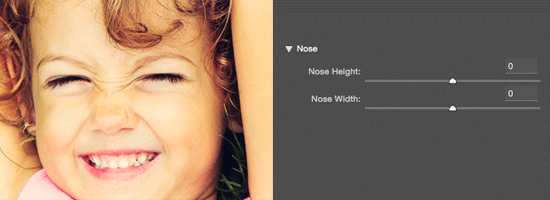
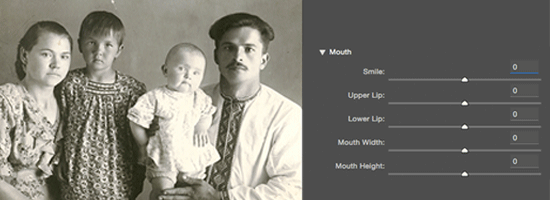
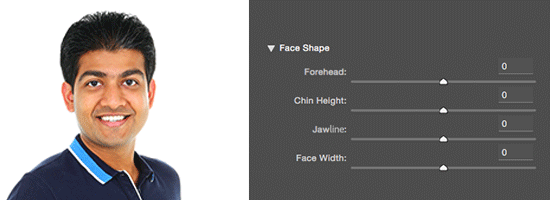
- When you're satisfied with the changes, click OK.
You lot can use a combination of on-screen handles and sliding controls for better control over Face-Aware Liquify changes.
Useful considerations
- Face-Aware Liquify functionality works best on facial features facing the camera. For best results, rotate any titled faces earlier applying the settings.
- The Reconstruct and Restore All options don't utilise to Face-Aware Liquify changes. Use Reset andAll options in the Face-Aware Liquify area to reset the changes practical to a selected face and all faces, respectively.
Several tools in the Liquify dialog box misconstrue the brush area when you lot hold downward the mouse button or drag. The distortion is concentrated at the eye of the brush area, and the issue intensifies as you hold downward the mouse push button or repeatedly drag over an area.
Forrad Warp tool
![]()
Pushes pixels forward as you drag.
Shift-click with the Warp tool, the Button Left tool, or the Mirror tool to create the consequence of dragging in a direct line from the previous point you clicked.
Reconstruct tool
![]()
Reverses the distortion you've already added, equally you hold down the mouse push button and drag.
Twirl Clockwise tool
![]()
Rotates pixels clockwise as yous hold down the mouse button or drag. To twirl pixels counterclockwise, hold down Alt (Windows) or Choice (Mac OS) as you concord down the mouse button or drag.
Crease tool
![]()
Moves pixels toward the center of the castor expanse equally you agree downwards the mouse push button or elevate.
Bloat tool
![]()
Moves pixels away from the centre of the castor area as you concur down the mouse button or elevate.
Push Left tool
![]()
Moves pixels to the left when you elevate the tool straight up (pixels move to the correct if you elevate down). You lot tin likewise elevate clockwise around an object to increase its size, or drag counterclockwise to decrease its size. To push button pixels right when yous elevate straight upward (or to move pixels left when you elevate down), hold downwardly Alt (Windows) or Option (Mac Bone) as you lot drag.
In the tool options area of the dialog box, set up the following options:
Brush Size
Sets the width of the brush you'll use to distort the prototype.
Brush Density
Controls how a castor feathers at the edge. An effect is strongest in the middle of the brush and lighter at the edge.
Brush Pressure
Sets the speed at which distortions are made when you drag a tool in the preview image. Using a low brush pressure makes changes occur more slowly, so it's easier to stop them at exactly the right moment.
Brush Rate
Sets the speed at which distortions are applied when you go on a tool (such as the Twirl tool) stationary in the preview image. The higher the setting, the greater the speed at which distortions are applied.
Stylus Pressure
Uses pressure readings from a stylus tablet. (This option is available just when you are working with a stylus tablet.) When selected, the brush pressure for the tools is the stylus pressure multiplied by the Brush Pressure level value.
Distort an image
If a type layer or a shape layer is selected, you must rasterize the layer before proceeding, making the type or shape editable by the Liquify filter. To distort type without rasterizing the blazon layer, use the Warp options for the Type tool.
-
Select the layer you desire to distort. To modify only part of the current layer, select that area.
-
Freeze areas of the image that yous don't want to alter.
-
Choose any of the liquify tools to misconstrue the preview image. Drag in the preview image to misconstrue the prototype.
-
After distorting the preview image, you can:
-
Use the Reconstruct tool
 or Reconstruct Options to fully or partially contrary the changes.
or Reconstruct Options to fully or partially contrary the changes. -
Use other tools to change the prototype in new means.
-
-
-
Click OK to close the Liquify dialog box and utilise the changes to the active layer.
-
Click Abolish to shut the Liquify dialog box without applying changes to the layer.
-
Hold down Alt (Windows) or Option (Mac Os) and click Reset to revert all distortions to the preview prototype and reset all options to their defaults.
You can use the Edit > Fade command to create boosted effects.
-
Freeze and thaw areas
You tin freeze areas that you don't want to modify or thaw frozen areas to make them editable again. You tin can also capsize both frozen and thawed areas.
Freeze areas
Past freezing areas of the preview image, you protect those areas from changes. Frozen areas are covered past a mask that you paint using the Freeze Mask tool![]() . You can also use an existing mask, selection, or transparency to freeze areas. You can view the mask in the preview paradigm to assistance y'all apply distortions.
. You can also use an existing mask, selection, or transparency to freeze areas. You can view the mask in the preview paradigm to assistance y'all apply distortions.
Using the Freeze Mask tool
Select the Freeze Mask tool![]() and elevate over the surface area you want to protect. Shift-click to freeze in a direct line between the electric current point and the previously clicked point.
and elevate over the surface area you want to protect. Shift-click to freeze in a direct line between the electric current point and the previously clicked point.
Using an existing selection, mask, or transparency channel
If you're applying the Liquify filter to a layer with a selection, layer mask, transparency, or alpha channel, choose Selection, Layer Mask, Transparency, or Quick Mask from any of the five icons' pop‑upwards card in the Mask Options expanse of the dialog box. This determines how areas of the preview image are frozen or masked.
Freezing all thawed areas
Click Mask All in the Mask Options area of the dialog box.
Inverting thawed and frozen areas
Click Capsize All in the Mask Options surface area of the dialog box.
Showing or hiding frozen areas
Select or deselect Testify Mask in the View Options expanse of the dialog box.
Changing the color of frozen areas
Cull a color from the Mask Color pop‑up carte in the View Options area of the dialog box.
Mask options with the Liquify filter
When you lot accept an existing choice, transparency, or mask in an image, that data is retained when the Liquify dialog box opens. You tin can choose 1 of the following mask options:
Supersede Selection
![]()
Shows the selection, mask, or transparency in the original paradigm.
Add To Option
![]()
Shows the mask in the original image, so that you tin add together to the selection using the Freeze Mask tool. Adds selected pixels in channel to the current frozen area.
Subtract From Choice
![]()
Subtracts pixels in channel from the current frozen area.
Intersect With Selection
![]()
Uses only pixels that are selected and currently frozen.
Capsize Selection
![]()
Uses selected pixels to invert the current frozen area.
If a option exists, the filter limits the preview and processing to the rectangular surface area containing that selection. (For rectangular marquee selections, the selected expanse and preview are identical, then choosing Selection from the mask pick menus to a higher place has no effect.)
Thaw areas
To thaw frozen areas so they're editable, exercise any of the following:
-
Select the Thaw Mask tool
 , and elevate over the surface area. Shift-click to thaw in a straight line betwixt the current point and the previously clicked bespeak.
, and elevate over the surface area. Shift-click to thaw in a straight line betwixt the current point and the previously clicked bespeak. -
To thaw all frozen areas, click the None button in the Mask Options area of the dialog box.
-
To invert frozen and thawed areas, click Invert All in the Mask Options surface area of the dialog box.
Work with meshes
Using a mesh helps you see and proceed track of distortions. You can cull the size and color of a mesh, and relieve the mesh from 1 image and use it to other images.
-
To show a mesh, select Bear witness Mesh in the View Options area of the dialog box, and choose a mesh size and mesh color.
-
To just show a mesh, select Prove Mesh and then deselect Show Image.
-
To save a distortion mesh, after distorting the preview epitome, click Salve Mesh. Specify a name and location for the mesh file, and click Save.
-
To employ a saved distortion mesh, click Load Mesh, select the mesh file you want to utilize, and click Open. If the image and distortion mesh aren't the aforementioned size, the mesh is scaled to fit the image.
-
To utilize the last saved baloney mesh, click Load Last Mesh.
-
(Creative Cloud) Meshes are automatically saved in your document. Meshes applied to Smart Objects are compressed and re-editable.
(Creative Cloud) Embedded meshes, even compressed ones, increase file size.
Work with backdrops
Yous tin can choose to evidence just the active layer in the preview image, or you tin show boosted layers in the preview prototype as a backdrop. Using the Mode options, yous can position the properties in front of or backside the active layer to go on track of your changes, or to line up a distortion with another distortion fabricated in a unlike layer.
Only the active layer is distorted, even if other layers are displayed.
Showing the backdrop
Select Show Backdrop, then choose Background from the Utilise carte and an selection from the Mode menu.
Showing changes to the target layer without showing the backdrop
Select All Layers from the Use menu. Setting the Opacity to 0 shows but the target layer with the full effects of the Liquify filter. Setting the Opacity to a higher value shows less of the Liquify filter's effect on the target layer.
Changing the blending between the target layer and the properties
Specify a Opacity value.
Determining how the target layer and the backdrop are combined in the prototype preview
Choose an pick from the Mode carte du jour.
Hiding the backdrop
Deselect Bear witness Backdrop in the View Options area of the dialog box.
Reconstruct distortions
After you distort the preview paradigm, you tin can use a variety of controls and reconstruction modes to reverse changes or redo the changes in new ways. Reconstructions tin can be applied two ways. You can apply a reconstruction to the entire paradigm, smoothing out the distortion in unfrozen areas, or y'all tin can employ the reconstruction tool to reconstruct specific areas. If you want to prevent reconstruction of distorted areas, you can utilize the Freeze Mask tool.

A. Original imageB. Distorted with frozen areasC. Reconstructed in Rigid mode (using button)D. Thawed, edges reconstructed in Smooth way (using tool)
Reconstruct an entire image
Click Reconstruct in the Reconstruct Options area of the dialog box. Then, in the Revert Reconstruction dialog box, specify an corporeality and click OK.
Remove all distortions
Click Restore All in the Reconstruct Choice area of the dialog box. This removes distortions even in frozen areas.
Reconstruct role of a distorted image
-
Freeze areas you want to go along distorted.
-
Select the Reconstruct tool
 and specify brush options in the Tool Options area of the dialog box.
and specify brush options in the Tool Options area of the dialog box. -
Drag over the area yous want to reconstruct. Pixels movement more than quickly at the castor center. Shift-click to reconstruct in a directly line betwixt the current betoken and the previously clicked point.
Source: https://helpx.adobe.com/photoshop/using/liquify-filter.html
0 Response to "My Essentials Window in Photoshop Went Wide and I Need to Make It Skinny Again"
ارسال یک نظر